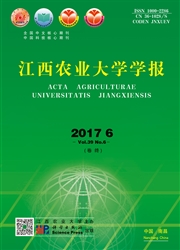

 中文摘要:
中文摘要:
对浙江庙山坞自然保护区毛竹林细根生物量、生产量和细根周转进行了研究,结果表明,庙山坞毛竹林细根生物量全年平均为8308 kg/hm^2,细根生物量存在着明显的季节动态,表现为单峰型,7月生物量最高,1月最低,相差22.81%。细根生物量的垂直分布在各季节基本一致,均表现为随土壤深度增加,生物量减少,0~20cm土层中竹林细根生物量占全深度的50%以上。庙山坞毛竹林细根年生产量为4820.67 kg/hm^2,根长生长量为7.520 1×10^7m/hm^2,竹林细根生产动态表现为,3~5月缓慢增加,5~7月急剧增加,此后增长速度减缓,1~3月处于停滞状态。毛竹林细根的径级分布因统计指标的不同有很大差异,直径小于0.5 mm的细根长度占了细根总长度的85.29%,表面积占总表面积的54.85%,其体积占总体积的25.85%,竹林细根以直径小于0.5mm细根为主,占细根长度的绝大部分。毛竹林细根周转率为0.68次/a,即细根全部周转1次需要1.47 a的时间。
 英文摘要:
英文摘要:
The fine root biomass, production and turnover of Phyllostachys pubescens stands in Miaoshanwu Nature Reserve were studied in this paper. The results showed that the yearly average biomass of fine root of Phyllostachys pubescens stands in Miaoshanwu Nature Reserve is 8 308 kg/hm^2. A noticeable seasonal dynamics exists for fine root biomass with the highest occurring in July and the lowest in January, and the difference is 22.81%. The vertical distribution of fine root biomass is similar among different seasons. The biomass decreases as the soil depth increases, with the fine root biomass in the soil layer of 0- 20 cm accounting for over 50% of the total. The annual production of fine roots is 4 820.67 kg/hm^2, with a root length production of 7. 520 1× 10^7 m/hm^2. A seasonal dynamics exists for fine root production also, with the production slowly increasing during March and May, sharply increasing during May and July, and almost stagnating during January and March. The diameter class distribution varies with the different measurement. The fine roots with the diameter less than 0.5 mm account for 85.29%, 54.85% and 25.85% in terms of the length, the surface area and volume respectively. The fine root with the diameter less than 0.5 mm takes the majority in terms of the length. The turn over rate of fine root is O. 68, that means that it takes 1.47 years for all the fine root to turn over.
 同期刊论文项目
同期刊论文项目
 同项目期刊论文
同项目期刊论文
 期刊信息
期刊信息
